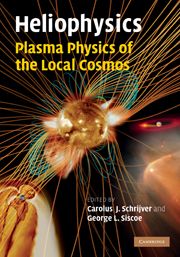Book contents
- Frontmatter
- Contents
- Preface
- 1 Prologue
- 2 Introduction to heliophysics
- 3 Creation and destruction of magnetic field
- 4 Magnetic field topology
- 5 Magnetic reconnection
- 6 Structures of the magnetic field
- 7 Turbulence in space plasmas
- 8 The solar atmosphere
- 9 Stellar winds and magnetic fields
- 10 Fundamentals of planetary magnetospheres
- 11 Solar-wind– magnetosphere coupling: an MHD perspective
- 12 On the ionosphere and chromosphere
- 13 Comparative planetary environments
- Appendix I Authors and editors
- List of illustrations
- List of tables
- References
- Index
2 - Introduction to heliophysics
Published online by Cambridge University Press: 05 August 2013
- Frontmatter
- Contents
- Preface
- 1 Prologue
- 2 Introduction to heliophysics
- 3 Creation and destruction of magnetic field
- 4 Magnetic field topology
- 5 Magnetic reconnection
- 6 Structures of the magnetic field
- 7 Turbulence in space plasmas
- 8 The solar atmosphere
- 9 Stellar winds and magnetic fields
- 10 Fundamentals of planetary magnetospheres
- 11 Solar-wind– magnetosphere coupling: an MHD perspective
- 12 On the ionosphere and chromosphere
- 13 Comparative planetary environments
- Appendix I Authors and editors
- List of illustrations
- List of tables
- References
- Index
Summary
Preamble
Walk along an island beach on a clear, breezy, cloudless night, or stand on the spine of a barren mountain ridge after sunset, and behold the firmament of stars glittering against the coal black sky above. They fill the sky with their timeless, brilliant flickering. With binoculars or even a small telescope one finds that even the lacey dark matrix between the vast sea of stars is populated with still more stars that are simply too faint to be seen with the naked eye. Within the Milky Way Galaxy, which stretches from horizon to horizon, the density of stars against the background sky is even greater.
Each twinkling point of light is a star not too unlike our own Sun. The Sun is just an ordinary star but it features prominently on the pages of this book because of its proximity. The next closest star, α-Centauri (which is a triple system in which Proxima Centauri is currently the closest to Earth), is almost a million times farther away (at 4.22 light years), and the remainder are farther still. We may now say with some confidence that many stars are surrounded by planets of various sizes. Some of these orbital companions are so immense that they are stars in their own right: double-star systems are quite common.
With the same measure of confidence we may assert that most of these stars possess magnetic fields; that these magnetic fields create hot outer atmospheres, or coronae, that drivemagnetized winds from their stars; and that these variable plasma winds blow past the orbiting planets, distorting their individual magnetospheres, and push outward against the surrounding interstellar medium.
- Type
- Chapter
- Information
- Heliophysics: Plasma Physics of the Local Cosmos , pp. 21 - 41Publisher: Cambridge University PressPrint publication year: 2009



